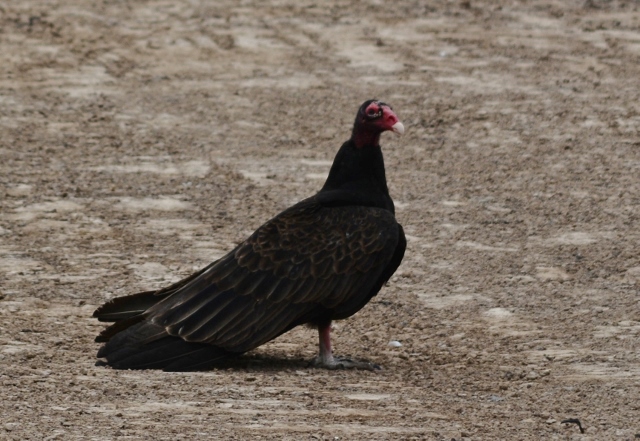By Anita Westervelt, Texas Master Naturalist
Beautiful when effortlessly soaring on the thermals with out-stretched wings, up close, their bare-skinned red head with greenish warts and hooked white bill do not an attractive bird make.

Not everyone appreciates turkey vultures but these carrion scavengers perform a much-needed environmental service. I think of them as the Waste Management conglomerate of Mother Earth.
Although we have turkey vultures all year, an abundance of them come for a winter stay. A familiar sight, they are easily identifiable in the sky. Hulking on a dead mesquite branch, head hunched Dracula-cape-esque, though, they can give one pause, a sight that greeted me one morning. Condor was my first thought, momentarily forgetting I was in Deep South Texas.
The bird lifted off with a powerful flap of wings, circled the Resaca then buzzed six feet over my head showing a great expanse of white on its under belly. Too big to be a hawk, very little red in the head area, so couldn’t be a vulture. Turned out, it was a juvenile turkey vulture, Cathartes aura.
The word tenacious comes to mind with turkey vultures. One morning on a busy road, a vulture zipped up about six feet and then down, smack in the middle of the road. It repeated this with each passing car. It was still there in the afternoon. I wondered why it didn’t just haul the road kill to the side of the road where it would be safer.
A bit of research gave an answer. Turkey vultures are unable to carry off their carrion. Their feet are chicken like, not talon-like as hawks or eagles. They are the only scavenger birds that can’t kill their prey.
Their beak, however, can pierce through the toughest cow hide.

A turkey vulture’s diet consists entirely of dead animal remains. There’s an opportune time as far as road kill — the fresher the better. They won’t eat extremely rotted carcasses.
Turkey vultures are among the very few birds that can smell. They can smell carrion less than 12-24 hours old. They detect by sight, but also rely heavily on their sense of smell. They can sniff out a dead critter from more than a mile away. Their sense of smell is so acute that they can even locate hidden food like something as small as a dead rat under a pile of leaves. They’ve been known to cruise 30 to 50 miles in search of food. They are more likely to search out food away from urban areas.
An adult turkey vulture wingspan reaches to six feet. They can swoop up to 60 mph. In spite of their large size, turkey vultures surprisingly only weigh between two to four pounds.
Because of their light weight, they can virtually float in the sky using the thermal currents (rising columns of air) to get around the skies. This technique uses very little energy as the vultures rarely need to flap their wings. It has been noted that vultures are so efficient at finding thermals, hawks will look for kettles of vultures and then fly over to take advantage of the rising air.
When flying, turkey vultures, hold their wings in a “V” above their backs, creating a slight angle that stabilizes their flight in turbulence.
Turkey vultures possess an unusual defense mechanism — they regurgitate their last meal. Apparently a worse smell than decaying meat and effective against any predator with a sense of smell.
Their scientific name, Cathartes aura, provides a clue to their place in the ecosystem. Cathartes comes from the Greek word meaning “purify,” and gratefully, they do as they scavenge the landscape, eating carrion.
